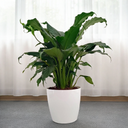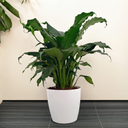Product Specifications
The Peace Lily (Spathiphyllum), also known as the Spath, is a striking and elegant indoor plant cherished for its beautiful foliage and graceful flowers. Native to the tropical rainforests of Central and South America, this plant is renowned for its ability to thrive in low-light conditions, making it a popular choice for various indoor environments.
The Peace Lily is characterized by its large, glossy, dark green leaves that form a lush, dense mound. The plant's standout feature is its stunning white flowers, which consist of a large, leaf-like spathe surrounding a central spadix. These flowers bloom sporadically throughout the year, adding a touch of sophistication and serenity to any space. The contrast between the pristine white blooms and the deep green leaves creates a visually striking effect, enhancing the plant's decorative appeal.
In terms of care, the Peace Lily is relatively low-maintenance, making it suitable for both novice and experienced plant enthusiasts. It flourishes in bright, indirect light but is adaptable to lower light conditions. However, it should be protected from direct sunlight, which can scorch the leaves. The plant prefers consistently moist soil but should not be overwatered; allowing the top inch of soil to dry out between waterings is ideal. It is also sensitive to overwatering, so proper drainage is essential to prevent root rot.
The Peace Lily enjoys warm temperatures between 65-80°F (18-27°C) and benefits from moderate to high humidity. In dry indoor environments, regular misting or a humidity tray can help maintain the necessary moisture levels. Additionally, the plant is effective at improving indoor air quality by filtering out common pollutants like formaldehyde, benzene, and trichloroethylene, and it helps to increase humidity levels, creating a healthier and more comfortable living environment.
Overall, the Peace Lily's combination of elegant appearance, air-purifying capabilities, and ease of care makes it a valued addition to any home or office. Its ability to enhance indoor spaces with its graceful blooms and lush foliage, along with its health benefits, underscores its popularity as a decorative and functional houseplant.
1. Air Purification: Peace Lilies are excellent at improving indoor air quality. They help filter out common indoor pollutants such as formaldehyde, benzene, trichloroethylene, and ammonia. This contributes to a healthier living environment.
2. Humidity Regulation: The plant helps increase indoor humidity through transpiration, which can be beneficial for both the plant itself and the occupants of the space, particularly in dry indoor environments.
3. Aesthetic Appeal: With its elegant white flowers and lush, dark green foliage, the Peace Lily adds a touch of sophistication and tranquility to any indoor space. It can enhance the decor of homes, offices, and other environments.
4. Low Maintenance: Peace Lilies are relatively easy to care for and can tolerate a range of indoor conditions, including lower light levels. Their forgiving nature makes them a great choice for both novice and experienced plant enthusiasts.
5. Stress Reduction: The presence of indoor plants, including Peace Lilies, has been associated with reduced stress and improved mental well-being, contributing to a more pleasant and calming environment.
1. Light: Peace Lilies prefer bright, indirect light but can tolerate low light conditions. Direct sunlight should be avoided, as it can scorch the leaves.
2. Watering: Keep the soil consistently moist but not waterlogged. Water when the top inch of soil feels dry. Peace Lilies are sensitive to overwatering, so ensure proper drainage. They can tolerate occasional drying out but prefer regular watering.
3. Soil: Use a well-draining potting mix rich in organic matter. A standard houseplant mix with added perlite or peat moss works well.
4. Temperature: Peace Lilies thrive in warm temperatures ranging from 65-80°F (18-27°C). They should be kept away from cold drafts and temperatures below 50°F (10°C).
5. Humidity: They enjoy moderate to high humidity. Regular misting or placing a humidity tray nearby can help maintain adequate moisture levels in dry indoor environments.






